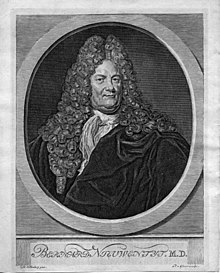Bernard Nieuwentyt
Bernard Nieuwentijt, Nieuwentijdt, ou Nieuwentyt (West-Graftdijk, 10 de agosto de 1654 — Purmerend, 30 de maio de 1718) foi um filósofo, matemático, médico, magistrado, prefeito (de Purmerend) e teólogo holandês.

Carreira
editarComo filósofo, Nieuwentyt era um seguidor de René Descartes e um oponente de Baruch Spinoza. Em 1695, ele se envolveu em uma controvérsia sobre os fundamentos do cálculo infinitesimal com Leibniz.[1] Nieuwentijt defendia infinitesimais 'nilsquare' (que têm potências maiores de zero), enquanto Leibniz estava incerto sobre adotar explicitamente tal regra - eles, no entanto, passaram a ser usados em toda a física a partir de então.
Ele escreveu vários livros (em holandês), incluindo sua obra principal Het regt gebruik der werelt beschouwingen, ter overtuiginge van ongodisten en ongelovigen [O Verdadeiro Uso da Contemplação do Mundo] (1715), que defendia a existência de Deus e atacou Spinoza.[2] Passou por várias edições (1715, 1717, 1720, 1725, 1730, 1740) publicadas por Joannes Pauli, e foi traduzido para o inglês, intitulada The religious philosopher, or the right use of contemplating the works of the Creator (1718) e para ofrancês: De l'existence de Dieu démontrée par les merveilles de la nature, ou traité téléologique dirigé contre la doutrina de Spinoza par un médecin hollandais. Voltaire possuía uma cópia deste livro, e foi uma influência sobre William Paley, na medida em que em 1859, Robert Blakey poderia fazer a detailed argument for plagiarism por Paley.[2][3] À versão em inglês foi acrescentada em uma carta ao tradutor de John Theophilus Desaguliers.[4] Gronden van zekerheid, publicado, de forma póstuma, por Nieuwentyt [Fundaments of Certitude, or the Right Method of Mathematicians in the Ideal as well as the Real] (1720) argumentou que o “método geométrico” de Spinoza não era o “método experimental” adequado da ciência. A obra também contém uma crítica do argumento ontológico semelhante a uma crítica posterior de Kant.[5]
Obras
editar- Het regt gebruik der werelt beschouwingen, ter overtuiginge van ongodisten en ongelovigen, Amsterdã, 1715
- O Filósofo Religioso, 1718
- Gronden van Zekerheid, 1720
Ver também
editarReferências
- ↑ Beth, Evert W (1950). «Critical Epochs in the Development of the Theory of Science». British Journal for the Philosophy of Science. 1 (1): 27–42. doi:10.1093/bjps/I.1.27
- ↑ a b Jonathan Israel, Enlightenment Contested, p. 385–6
- ↑ Benjamin C. Jantzen (2014). An Introduction to Design Arguments. [S.l.]: Cambridge University Press. pp. 168–169. ISBN 978-0-521-18303-1
- ↑ Bernard Nieuwentyt The Religious Philosopher: Or, The Right Use of Contemplating the Works of the Creator, Vol. II (transl. by John Chamberlayne) Cambridge: Cambr. Uni. Press, 2015
- ↑ Beth, Evert W (1950). «Critical Epochs in the Development of the Theory of Science». British Journal for the Philosophy of Science. 1 (1): 27–42. doi:10.1093/bjps/I.1.27
Bibliografia
editar- E. W. Beth, Nieuwentyt's significance for the philosophy of science, Synthese, Vol. 9 No. 1, 1955, pp. 447-453 (Published also as Chapter V in Science: a Road to Wisdom, D. Reidel Publishing Company, Dordrecht, Holland, 1972, Print ISBN 978-94-011-7646-0, DOI 10.1007/978-94-011-7644-6_5.)
- Gysel C., Odontology, theology and antispinozism according to Bernard Nieuwentyt (1654-1718), Ned Tijdschr Tandheelkd, 1977 Jun; 84(6):214-6.
- Michael John Petry (1979). Nieuwentijt's Criticism of Spinoza, E. J. Brill.
- R. H. Vermij (1989). Een zekere, zakelijke wijsbegeerte. Tijdschrift Voor Filosofie 51 (3):544-544.
- JANTZEN, BENJAMIN C.. An Introduction to Design Arguments. CAMBRIDGE UNIVERSITY PRESS, 2014. ISBN 978-1-107-00534-1 Hardback, ISBN 978-0-521-18303-1 Paperback.
Ligações externas
editar- Obras de ou sobre Bernard Nieuwentyt (em inglês) nas bibliotecas do catálogo WorldCat)
- Bernard Nieuwentyt. O Filósofo Religioso: Ou, O Uso Correto de Contemplar as Obras do Criador, Vol. II. Cambridge: Cambridge. Uni. Press, 2015 (em inglês)